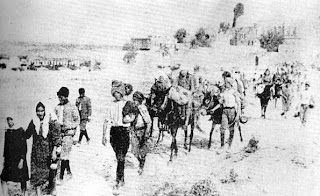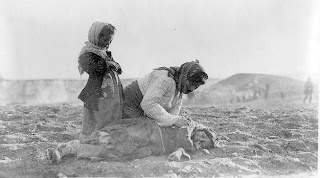1912-1915 Taurus Mts. & Adana [Construction of the Berlin to Baghdad Railway]
The railroad became a source of international disputes during the years immediately preceding World War I. Technical difficulties in the remote Taurus Mountains and diplomatic delays meant that by 1915 the railway was still 480 kilometres (300 mi) short of completion. Construction resumed in the 1930s and was completed in 1940.
By 1915 the railway ended some 50 miles east of Diyarbakır. Another spur, heading east from Aleppo, ended at Nusaybin. Additionally some rail was laid starting in Baghdad reaching north to Tikrit and south to Kut. This left a gap of some 300 miles between the railroad lines. Additionally, there were three mountains which the railroad was going to go through, but the tunnels through these three mountains were not complete. So the railroad was, in fact, broken into four different sections at the start of the war. The total time to get from Istanbul to Baghdad during the war was 22 days.[24] The total distance was 1,255 miles (2019 km).
The railway passed through the following towns and places, in the order given, north to south: Konya, Anatolian table lands, Karaman, Ereğli, the foothills of Taurus, Gülek Pass, Çukurova plain, Adana, Yenice, Amanus range, Aleppo, Nusaybin, Mosul, Baghdad, and Basra.
GERMAN
ENGINEERS AND GERMAN CAPITAL were largely responsible for the construction of
the railway to Baghdad Taurus Mountains was
completed during the war of 1914-1918. The original idea was to penetrate the
range by one tunnel, but a series of twelve tunnels and bridges had to be
built. The concrete bridges have a total length of 362 yards, and the tunnels a
total length of 7 miles 580 yards. Above is a viaduct between two tunnel
mouths.
BRIDGING A GORGE in the Taurus Mountains . During the war of 1914-18 the Baghdad
Railway became of strategic importance, and, to speed up construction,
narrow-gauge lines were first laid. The alteration of the Taurus line to
standard gauge did not take place until October, 1918. The above photograph was
taken during the early days of the enterprise. After the Armistice with Turkey
A
TUNNEL MOUTH IN THE TAURUS MOUNTAINS . Boring
had to be carried out mostly through limestone rock. Tunnels were lined only in
the sections which required strengthening ; but in the majority of places no
lining was necessary, as the rock was sufficiently hard and solid.
GREAT
DIFFICULTIES were experienced by the railway engineers in driving a way through
the Amanus Mountains Adana Aleppo
THE WORKSHOPS AT BELEMEDIK erected
for the building of the Baghdad Railway. The Taurus Mountains can be seen
towering up in the background. For the task of surveying alone fourteen miles
of road had to be laid and several thousand men were employed.
THE RIVER EUPHRATES, of historic
renown, is crossed by a steel girder bridge of ten spans, each ot 263 ft. The
bridge, over which passes the "Taurus Express," rests on masonry
piers built on oak piles that were driven down by special steel sheet
cofferdams to a depth of over 30 ft. below the river bed. The bridge is near
the station of Jerablus.
GERMAN-BUILT LOCOMOTIVE of the type
used to haul the "Taurus Express" between Haydarpasa and Adana, on
the Turkish State Railways. The Turkish lines have some 550 locomotives in
operation, and large numbers of these are of German manufacture.
The archive photo of one
the way Germans assisted Turkey during WWI. The vast empty spaces that
comprised the Ottoman Empire made the aircraft an invaluable reconnaissance
tool. This aircraft has been transported to Turkey along the famous Berlin to
Bagdad railway and is being unloaded for reassembly. Germany thus gave Turkey
the power to tie down hundreds of thousands of Allied troops.
Ancient city of the Caliphs now in British
hands. British troops entering Bagdad after their victorious Mesopotamian
campaign and shattering the German dream of the "Berlin-to-Bagdad"
railway and domination of the east.










.jpg)



.png)

























































